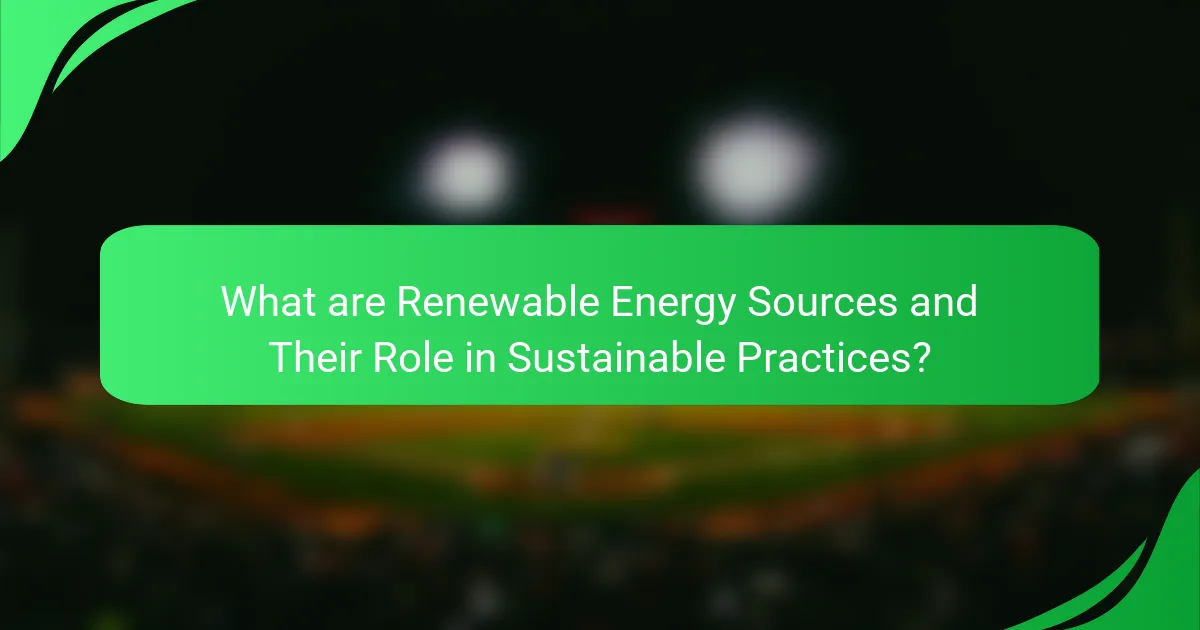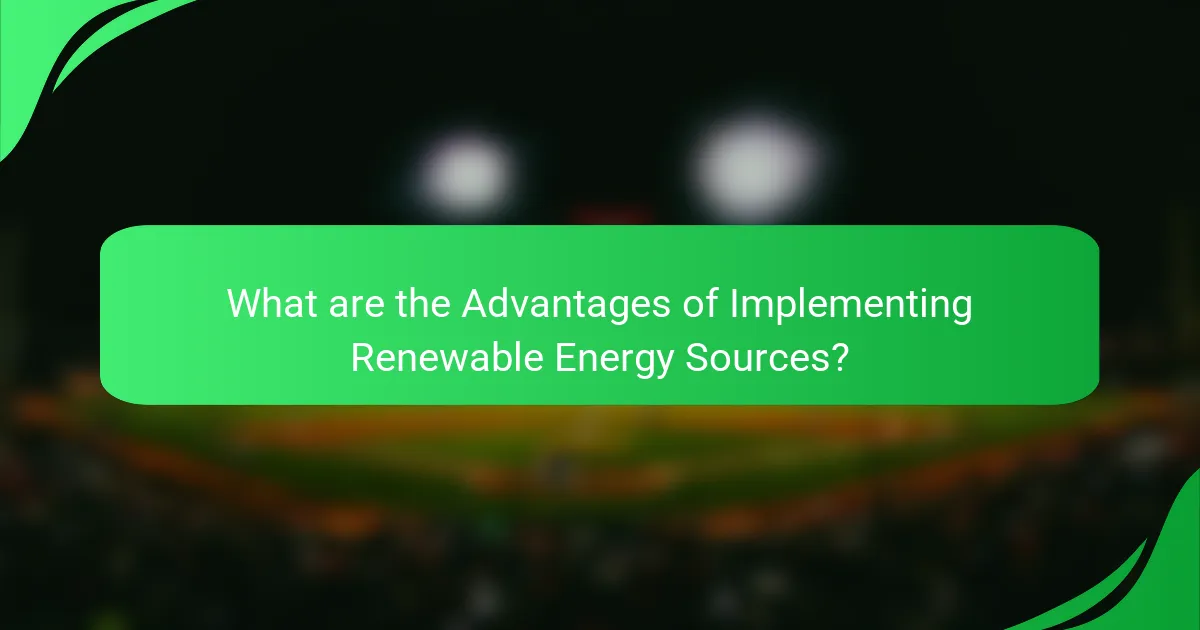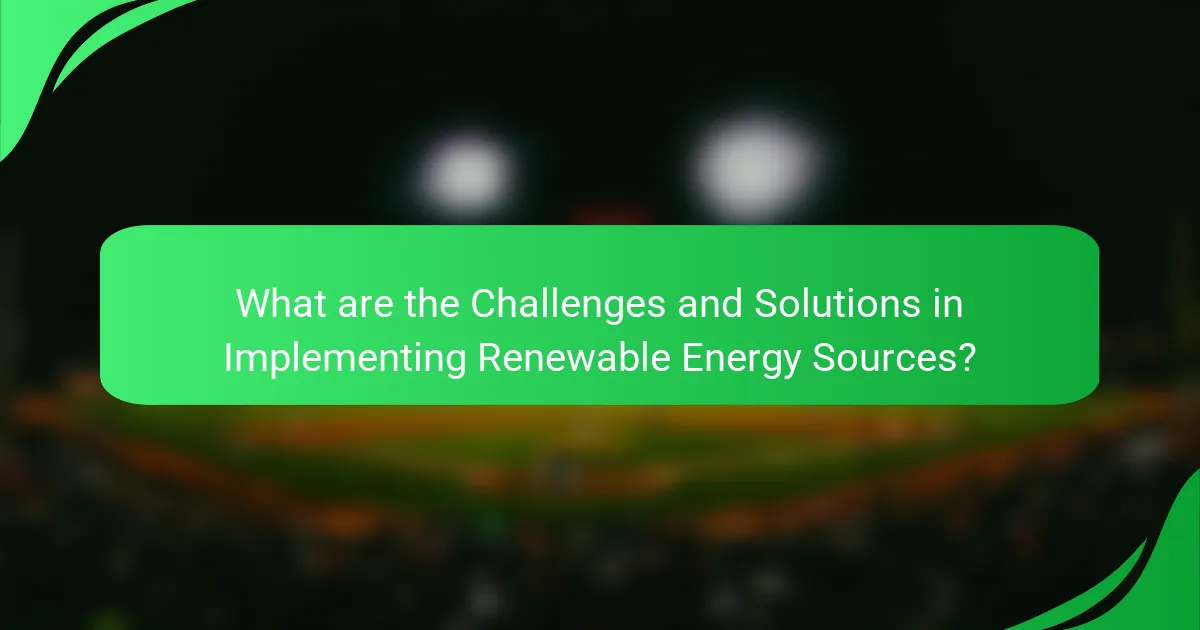Renewable energy sources, including solar, wind, hydroelectric, geothermal, and biomass energy, are derived from natural processes that are continuously replenished. These energy forms are essential for sustainable practices as they significantly reduce greenhouse gas emissions and enhance energy security. The article examines the advantages of renewable energy, such as lower emissions, sustainability, energy independence, job creation, and potential cost reductions. It also addresses challenges like high initial costs, intermittency, and infrastructure limitations, while proposing solutions such as government incentives, technological advancements, and grid modernization to facilitate the implementation of renewable energy sources.

What are Renewable Energy Sources and Their Role in Sustainable Practices?
Renewable energy sources are energy forms derived from natural processes that are replenished constantly. These sources include solar, wind, hydroelectric, geothermal, and biomass energy. They play a crucial role in sustainable practices by reducing greenhouse gas emissions. For example, solar energy can significantly decrease reliance on fossil fuels. Wind energy contributes to cleaner air by generating electricity without pollutants. Hydroelectric power harnesses water flow to produce energy sustainably. Geothermal energy utilizes heat from the Earth, providing a consistent energy supply. Biomass energy converts organic materials into fuel, promoting waste reduction. The adoption of these sources supports environmental conservation and energy security. According to the International Renewable Energy Agency, renewable energy accounted for 29% of global electricity generation in 2020. This demonstrates their growing importance in achieving sustainability goals.
How do renewable energy sources contribute to sustainability?
Renewable energy sources contribute to sustainability by reducing greenhouse gas emissions. They provide clean energy that does not deplete natural resources. For example, solar energy harnesses sunlight, while wind energy captures wind currents. Both methods generate electricity without harmful emissions. According to the International Renewable Energy Agency, renewable energy can cut global CO2 emissions by up to 70% by 2050. This transition helps combat climate change and promotes environmental health. Additionally, renewable energy sources create jobs in manufacturing, installation, and maintenance. They also enhance energy security by diversifying energy supply. Overall, renewable energy plays a crucial role in achieving a sustainable future.
What are the key characteristics of renewable energy sources?
Renewable energy sources are characterized by their ability to regenerate naturally. They include solar, wind, hydro, geothermal, and biomass energy. These sources are sustainable and have a lower environmental impact compared to fossil fuels. Renewable energy is abundant and can be harnessed in various locations. They produce little to no greenhouse gas emissions during operation. The technology for capturing renewable energy is continuously advancing. This results in increased efficiency and reduced costs over time. According to the International Renewable Energy Agency, renewable energy could account for 86% of global power demand by 2050.
Why is sustainability important in the context of energy consumption?
Sustainability is crucial in energy consumption to reduce environmental impact and ensure resource availability. It promotes the use of renewable energy sources, which produce less greenhouse gas emissions. For instance, the International Energy Agency reported that renewable energy could help reduce global CO2 emissions by 70% by 2050. Sustainable energy practices also enhance energy security by diversifying energy sources. This reduces dependence on fossil fuels, which are finite and subject to market volatility. Furthermore, sustainable energy consumption fosters economic growth by creating jobs in the renewable sector. According to the International Renewable Energy Agency, the renewable energy sector employed over 11 million people worldwide in 2018. Therefore, sustainability in energy consumption is vital for environmental health, economic stability, and resource conservation.
What types of renewable energy sources are commonly used?
The commonly used types of renewable energy sources include solar, wind, hydroelectric, geothermal, and biomass. Solar energy harnesses sunlight through photovoltaic cells or solar thermal systems. Wind energy captures kinetic energy from wind using turbines. Hydroelectric power generates electricity from flowing water, typically via dams. Geothermal energy utilizes heat from the Earth’s core for heating and electricity. Biomass energy comes from organic materials, such as plant and animal waste, which can be converted into fuel. These renewable sources contribute to reducing greenhouse gas emissions and promoting sustainability.
What is solar energy and how is it harnessed?
Solar energy is the energy derived from the sun’s radiation. It can be harnessed through various technologies. Photovoltaic cells convert sunlight directly into electricity. Solar thermal systems capture heat from the sun for heating applications. Concentrated solar power uses mirrors to focus sunlight to generate steam and drive turbines. Solar panels are commonly installed on rooftops or in solar farms. The global capacity for solar energy has been growing rapidly, reaching over 900 gigawatts in 2020. This demonstrates the increasing reliance on solar energy as a renewable resource.
How is wind energy generated and utilized?
Wind energy is generated by converting the kinetic energy of wind into mechanical power. Wind turbines capture wind through their blades, which rotate around a hub. This rotation drives a generator that converts mechanical energy into electricity. The electricity produced is then transmitted through power lines for use in homes and businesses. Wind energy can also be stored in batteries or used directly for applications such as water pumping. According to the U.S. Department of Energy, wind energy accounted for about 8.4% of total electricity generation in the United States in 2021. This demonstrates its growing role in the renewable energy sector.
What are the benefits of using hydropower?
Hydropower provides several significant benefits. It generates electricity with low greenhouse gas emissions. This contributes to reducing climate change impacts. Hydropower is a renewable energy source, relying on the water cycle. It offers a stable and reliable energy supply. Hydropower plants can adjust output quickly to meet demand. This flexibility supports grid stability and integration of other renewables. Additionally, hydropower can create recreational opportunities and enhance local ecosystems. According to the International Hydropower Association, hydropower accounts for about 16% of global electricity generation.
What role does biomass play in renewable energy?
Biomass plays a crucial role in renewable energy by providing a sustainable source of fuel. It consists of organic materials, such as plant and animal waste. Biomass can be converted into biofuels like ethanol and biodiesel. These biofuels can replace fossil fuels in transportation and heating. According to the U.S. Energy Information Administration, biomass accounted for about 5% of total U.S. energy consumption in 2020. This demonstrates its significance in the energy mix. Biomass also helps reduce greenhouse gas emissions when managed sustainably. It contributes to a circular economy by recycling waste into energy.
How does geothermal energy contribute to sustainable practices?
Geothermal energy contributes to sustainable practices by providing a reliable and renewable energy source. It reduces dependence on fossil fuels, which lowers greenhouse gas emissions. The Earth’s internal heat is continuously replenished, making geothermal energy sustainable over the long term. According to the U.S. Department of Energy, geothermal power plants can operate with minimal environmental impact. They require less land and water compared to other energy sources. Additionally, geothermal systems can provide consistent energy, unlike solar and wind, which are intermittent. This reliability supports a stable energy grid, enhancing overall sustainability in energy practices.

What are the Advantages of Implementing Renewable Energy Sources?
Implementing renewable energy sources offers numerous advantages. Firstly, they reduce greenhouse gas emissions significantly. According to the International Energy Agency, renewable energy can lower global CO2 emissions by up to 70% by 2050. Secondly, renewable energy sources are sustainable and inexhaustible. Solar and wind energy are abundant and can be harnessed indefinitely. Thirdly, they promote energy independence. Countries can reduce reliance on imported fossil fuels, enhancing national security. Additionally, renewable energy creates jobs. The U.S. Department of Energy reported that solar and wind sectors employ over 400,000 workers. Lastly, renewable energy can lead to lower energy costs over time. As technology advances, the cost of solar panels and wind turbines continues to decline.
How do renewable energy sources impact the environment positively?
Renewable energy sources positively impact the environment by reducing greenhouse gas emissions. They produce energy without the carbon footprint associated with fossil fuels. For instance, solar energy systems generate electricity without air pollutants. Wind turbines harness wind energy, offering a clean alternative to coal and gas. Hydropower utilizes flowing water, contributing to lower emissions. According to the International Renewable Energy Agency, renewable energy could reduce global CO2 emissions by up to 70% by 2050. Additionally, these sources promote biodiversity by minimizing habitat destruction. Overall, renewable energy supports a sustainable future through environmental preservation and cleaner air.
What are the reductions in greenhouse gas emissions associated with renewables?
Renewable energy sources significantly reduce greenhouse gas emissions. For example, solar energy can reduce emissions by approximately 90% compared to fossil fuels. Wind energy also contributes to a reduction of about 70% in greenhouse gas emissions. According to the International Renewable Energy Agency, transitioning to renewables could cut global CO2 emissions by up to 70% by 2050. This transition helps mitigate climate change and promotes environmental sustainability. Additionally, hydropower can lower emissions by about 50% compared to traditional energy sources. Overall, renewables play a crucial role in decreasing greenhouse gas emissions and combating global warming.
How do renewable energy sources promote energy independence?
Renewable energy sources promote energy independence by reducing reliance on imported fossil fuels. They provide local energy generation, which enhances energy security. Countries utilizing solar, wind, and hydroelectric power can produce energy domestically. This minimizes vulnerability to global market fluctuations. According to the U.S. Energy Information Administration, renewable energy accounted for 20% of U.S. electricity generation in 2020. Increased investment in renewables can lead to job creation in local economies. Additionally, renewable energy projects often involve community engagement and local ownership. These factors collectively contribute to a more resilient and self-sufficient energy framework.
What economic benefits arise from the use of renewable energy?
Renewable energy provides significant economic benefits. It creates jobs in manufacturing, installation, and maintenance. The International Renewable Energy Agency reported that renewable energy jobs reached 11.5 million globally in 2018. Renewable energy reduces dependence on imported fuels, enhancing energy security. This leads to stable energy prices and lower vulnerability to market fluctuations. Investment in renewable energy drives technological innovation, fostering economic growth. According to a report by the International Renewable Energy Agency, transitioning to renewable energy could generate $2 trillion in global economic benefits by 2030. Additionally, renewable energy projects often have lower operational costs over time compared to fossil fuels. This results in long-term savings for consumers and businesses.
How can renewable energy sources create job opportunities?
Renewable energy sources can create job opportunities through the development, installation, and maintenance of energy systems. The renewable energy sector has been rapidly expanding. This growth leads to increased demand for skilled labor in various fields. Solar and wind energy projects require engineers, technicians, and construction workers. According to the International Renewable Energy Agency, over 11 million people were employed in renewables globally by 2018. This number is projected to rise as investment in clean energy increases. Job opportunities also arise in research and development for new technologies. The transition to renewable energy supports local economies and fosters job creation across multiple sectors.
What are the long-term cost savings associated with renewable energy?
Long-term cost savings associated with renewable energy include reduced energy bills and lower maintenance costs. Renewable energy sources, such as solar and wind, have minimal fuel costs. Over time, this leads to significant savings compared to fossil fuels. According to a report by the International Renewable Energy Agency, the cost of solar energy has decreased by 89% since 2009. Additionally, renewable systems often have longer lifespans, resulting in lower replacement costs. The U.S. Department of Energy states that wind energy can save consumers up to $1.6 billion annually. Transitioning to renewable energy can also mitigate the financial risks associated with fluctuating fossil fuel prices.

What are the Challenges and Solutions in Implementing Renewable Energy Sources?
The challenges in implementing renewable energy sources include high initial costs, intermittency, and infrastructure limitations. High initial costs can deter investment in renewable technologies. For example, solar and wind installations require significant upfront capital. Intermittency refers to the variable nature of renewable energy generation. Solar energy is only available during daylight, while wind energy depends on weather conditions. Infrastructure limitations involve the need for upgraded grids to handle distributed energy sources. Solutions to these challenges include government incentives, technological advancements, and grid modernization. Government incentives can lower financial barriers for renewable projects. Technological advancements improve energy storage and efficiency. Grid modernization enhances the ability to integrate renewable sources effectively. Together, these solutions can address the challenges of renewable energy implementation.
What are the common barriers to adopting renewable energy?
Common barriers to adopting renewable energy include high initial costs, lack of infrastructure, and regulatory challenges. High initial costs deter investment in renewable technologies. For example, solar panel installation can require significant upfront capital. Lack of infrastructure limits the integration of renewable sources into existing energy grids. Many regions lack the necessary transmission lines and storage systems. Regulatory challenges often arise from outdated policies that favor fossil fuels. These barriers hinder the transition to renewable energy sources. Studies show that addressing these issues can significantly enhance adoption rates.
How can technological advancements overcome these barriers?
Technological advancements can overcome barriers in renewable energy adoption through improved efficiency and cost reduction. Innovations in solar panel technology have increased energy conversion rates, making solar power more viable. Wind turbine designs have enhanced energy capture, allowing for more power generation in diverse locations. Energy storage solutions, like advanced batteries, address intermittency issues by storing excess energy for later use. Smart grid technology optimizes energy distribution and consumption, reducing waste. These advancements lead to lower costs, making renewable energy more accessible. According to the International Renewable Energy Agency, the cost of solar energy has dropped by 82% since 2010. This significant reduction encourages wider adoption and investment in renewable sources.
What role do government policies play in renewable energy implementation?
Government policies are crucial in renewable energy implementation. They provide regulatory frameworks that encourage investment and development. Policies such as tax incentives and subsidies lower the financial barriers for renewable energy projects. For instance, the Investment Tax Credit (ITC) in the U.S. has significantly boosted solar energy installations. Additionally, government mandates for renewable energy usage create market demand. Countries with Renewable Portfolio Standards (RPS) have seen increased renewable energy generation. Furthermore, research funding from governments supports innovation in renewable technologies. Overall, effective government policies drive the transition to a sustainable energy future.
What strategies can be employed for successful implementation of renewable energy sources?
Successful implementation of renewable energy sources requires a multi-faceted approach. First, government policies must support renewable energy through incentives and subsidies. For example, tax credits can lower the financial burden on developers. Second, investment in infrastructure is crucial. Upgrading the grid to accommodate renewable energy can enhance efficiency. Third, public awareness campaigns can educate communities about the benefits of renewable energy. Studies show that informed citizens are more likely to support renewable initiatives. Fourth, collaboration between public and private sectors can drive innovation and funding. Joint ventures often lead to more effective solutions. Finally, research and development are essential for advancing technology. Continuous improvement can make renewable energy sources more viable and cost-effective.
How can communities transition to renewable energy effectively?
Communities can transition to renewable energy effectively by implementing comprehensive planning and stakeholder engagement. This includes assessing local energy needs and resources. Communities should establish clear goals for renewable energy adoption. They can create incentives for renewable energy projects, such as tax credits or grants. Education and outreach programs can raise awareness about renewable energy benefits. Collaboration with local governments and organizations can enhance resource sharing. Utilizing available funding sources for renewable energy initiatives is crucial. According to the U.S. Department of Energy, community-driven projects have increased renewable energy capacity significantly.
What are best practices for integrating renewable energy into existing systems?
Best practices for integrating renewable energy into existing systems include conducting a comprehensive energy audit. This audit identifies current energy usage and potential areas for improvement. Next, stakeholders should assess the compatibility of renewable technologies with existing infrastructure. This ensures seamless integration without major disruptions.
Implementing a phased approach is also crucial. Gradually introducing renewable sources allows for adjustments based on performance data. Additionally, investing in energy storage solutions can enhance reliability. These solutions store excess energy for use during peak demand.
Collaboration with local utilities is essential. Utilities can provide insights into grid capabilities and incentives for renewable adoption. Furthermore, continuous monitoring and optimization of energy systems ensure efficiency. Regular assessments help identify areas for further enhancement.
Training staff on new technologies is vital for successful integration. Knowledgeable personnel can effectively manage and maintain renewable systems. Lastly, engaging the community fosters support and understanding of renewable initiatives. This builds a collaborative environment for sustainable energy practices.
What are practical tips for individuals to support renewable energy initiatives?
Individuals can support renewable energy initiatives by adopting energy-efficient practices. They can reduce energy consumption by using LED bulbs and energy-efficient appliances. Installing solar panels on homes can harness clean energy and lower electricity bills. Supporting local renewable energy projects through community investments can drive growth in the sector. Participating in renewable energy programs offered by utility companies can help increase demand. Advocating for policies that promote renewable energy can influence local government decisions. Educating others about the benefits of renewable energy can raise awareness. Lastly, using public transportation or carpooling reduces fossil fuel reliance and supports cleaner alternatives.
The main entity of the article is renewable energy sources, which include solar, wind, hydroelectric, geothermal, and biomass energy. The article outlines their crucial role in sustainable practices by reducing greenhouse gas emissions and promoting energy independence. It discusses the advantages of renewable energy, such as job creation, economic benefits, and long-term cost savings, along with the challenges and solutions for implementation. Additionally, the article provides practical tips for individuals and communities to transition to renewable energy effectively, emphasizing the importance of government policies and technological advancements in overcoming barriers.